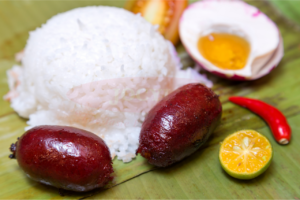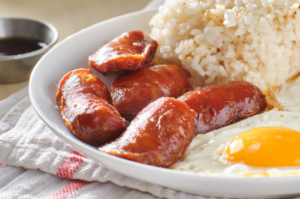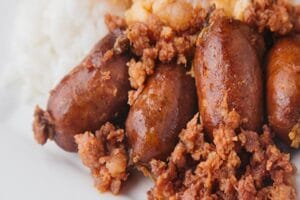
About Us
Jocyl's Food Products (a.k.a "Chorizo de Kalibo") is a bold and forward-thinking company whose goals are set to create surprising ways of developing and promoting our products. We are entrepreneurial and visionary in producing and marketing the best chorizo and other food products from our hometown - Kalibo, Aklan, Philippines.
About UsContact Info
- Tigayon Highway, Barangay Tigayon, Kalibo, Aklan
- +63362628688
- jocylsfoods@gmail.com
- Tigayon Highway, Barangay Tigayon, Kalibo, Aklan
- jocylsfoods@gmail.com
- +63362628688

Longganisa Cooking Tips: Your Ultimate Guide to Filipino Sausages
-
Jocyl's Food Products > Blog > Food > Longganisa Cooking Tips: Your Ultimate Guide to Filipino Sausages
Introduction to Longganisa Cooking Tips
Longganisa, a popular Filipino sausage, is known for its unique flavors and versatility in the kitchen. Whether you’re a seasoned cook or a novice in the culinary world, this ultimate guide will equip you with essential longganisa cooking tips and techniques to master the art of cooking irresistible longganisa. From selecting the right ingredients to achieving the perfect balance of flavors, let’s delve into the world of longganisa and discover the secrets behind creating mouthwatering sausages.
Understanding Longganisa: A Brief Overview
When it comes to Filipino cuisine, longganisa holds a special place in the hearts and palates of many. This delectable sausage is packed with unique flavors and has become an iconic dish that represents the vibrant and diverse culinary heritage of the Philippines. In this section, we will delve into the definition and origin of longganisa, explore the regional varieties and flavor profiles, and discover some of the most popular longganisa recipes in Filipino cuisine.
Definition and Origin of Longganisa
Longganisa, sometimes spelled as longanisa, is a type of sausage that is deeply rooted in Filipino culinary traditions. The name “longganisa” is derived from the Spanish word “longaniza,” which refers to a similar sausage found in Spanish cuisine. However, Filipino longganisa has evolved to have its own distinct characteristics and flavors.
Longganisa is typically made from ground meat, commonly pork, although variations using chicken, beef, or a combination of meats also exist. The meat is seasoned with a variety of herbs, spices, and other flavorings, giving each regional variety its unique taste.
Regional Varieties and Flavor Profiles
The Philippines is a country comprised of diverse regions, each with its own longganisa variety and flavor profile. Here are some of the notable regional longganisa varieties:
- Vigan Longganisa: Hailing from the city of Vigan in Ilocos Sur, Vigan longganisa is known for its garlicky and tangy flavor. It is typically made from lean ground pork, garlic, vinegar, and local spices. Vigan longganisa is often characterized by its reddish hue and slightly sour taste.
- Lucban Longganisa: Lucban, a municipality in Quezon province, is famous for its flavorful longganisa. Lucban longganisa is heavily seasoned with garlic, black pepper, and vinegar, giving it a bold and savory taste. It is usually made from a combination of pork and fat, resulting in a juicy and succulent texture.
- Pampanga Longganisa: Pampanga, known as the “Culinary Capital of the Philippines,” offers its own take on longganisa. Pampanga longganisa is characterized by its sweet and garlicky flavor profile. It incorporates brown sugar, soy sauce, and native spices, creating a delightful balance of sweet and savory notes.
- Cebu Longganisa: Cebu, an island province in the Visayas region, is famous for its unique longganisa variety. Cebu longganisa is often reddish in color and has a slightly sweet and tangy taste. It is commonly flavored with native herbs and spices like oregano, paprika, and garlic.
Popular Longganisa Recipes in Filipino Cuisine
Longganisa is a versatile ingredient that can be enjoyed in various ways. While it is commonly cooked as a standalone dish, it is also a popular ingredient in Filipino breakfasts, lunch and dinner meals, and even street food. Here are some popular longganisa recipes in Filipino cuisine:
- Longganisa with Garlic Rice and Fried Egg: This classic Filipino breakfast dish features pan-fried longganisa served with garlic rice and a sunny-side-up egg. The savory flavors of the longganisa complement the fragrant garlic rice, creating a satisfying and flavorful meal.
- Longganisa Pasta: Longganisa can add a unique twist to pasta dishes. Cooked longganisa is crumbled and sautéed with garlic, onions, and tomatoes before being tossed with cooked pasta. This fusion of flavors creates a delightful Filipino-Italian fusion dish.
- Longganisa Burger: Transform your longganisa into a patty and serve it on a bun with your favorite burger toppings. The rich and juicy flavors of the longganisa patty combined with the textures and flavors of traditional burger fixings create a mouthwatering experience.
- Longganisa Stir-Fry: Sliced longganisa can be stir-fried with vegetables such as bell peppers, onions, and carrots for a quick and flavorful meal. The natural sweetness of the longganisa complements the crispiness of the vegetables, resulting in a delightful stir-fry dish.
These are just a few examples of the many creative ways longganisa can be incorporated into Filipino cuisine. The possibilities are endless, allowing you to experiment and create your own unique longganisa dishes that suit your taste preferences.
Choosing the Right Longganisa Ingredients
To create delectable longganisa, it all starts with selecting the right ingredients. From quality meats to fresh herbs and spices, each component plays a crucial role in achieving exceptional flavor and texture. In this section, we will explore the importance of choosing the right longganisa ingredients, including the meats, herbs, spices, and flavor enhancers that will elevate your sausage-making to new heights.
Quality Meats: The Foundation of Great Longganisa
When it comes to longganisa, using quality meats is essential for achieving delicious results. The main choice of meat is typically pork, as it offers a good balance of fat and lean meat, resulting in a juicy and succulent texture. However, if you prefer a leaner option, you can opt for chicken, beef, or even a combination of meats.
When selecting your meat, choose cuts that are fresh and of high quality. Look for meats that are well-marbled, as the fat content contributes to the flavor and juiciness of the longganisa. If possible, visit a trusted butcher or local market to ensure the meat is fresh and free from any additives or preservatives.
Types of Meat for Longganisa: Pork, Chicken, Beef, or Combination
While pork is the traditional choice for longganisa, don’t be afraid to experiment with other types of meat. Chicken longganisa offers a lighter alternative with a slightly different flavor profile. Beef longganisa brings a distinct richness and robustness to the sausage. You can also try combining different meats to create a unique blend of flavors.
Keep in mind that different meats may require slight adjustments in the fat-to-meat ratio to achieve the desired texture and taste. Pork usually contains enough fat, but leaner meats like chicken or beef may require additional fat for moisture and flavor.
The Importance of Fresh Herbs and Spices
Fresh herbs and spices are essential ingredients that impart aromatic flavors to your longganisa. They add depth and complexity to the sausage, making each bite a delightful experience. While the specific herbs and spices may vary depending on the regional variety of longganisa, some common ones include garlic, black pepper, oregano, and paprika.
When selecting herbs and spices, opt for fresh ingredients whenever possible. Freshly crushed garlic, whole peppercorns, and dried herbs will provide the best flavor. If fresh herbs are not available, high-quality dried alternatives can be used. Avoid using pre-ground spices as they tend to lose their potency over time.
Exploring Flavor Enhancers: Vinegar, Soy Sauce, and Sugar
Apart from meats and herbs, flavor enhancers play a crucial role in elevating the taste of longganisa. Vinegar, soy sauce, and sugar are commonly used to add tanginess, umami, and sweetness to the sausage.
Vinegar provides acidity, which helps balance the richness of the meat and adds a tangy kick to the flavor profile. Locally made vinegar, such as coconut vinegar or cane vinegar, can enhance the authenticity of the dish.
Soy sauce contributes umami flavors and adds depth to the longganisa. It provides a savory undertone that complements the other ingredients. Opt for a good-quality soy sauce to ensure the best flavor.
Sugar is used to balance the flavors by adding a touch of sweetness. It helps round out the overall taste and enhances the caramelization during the cooking process. Brown sugar, muscovado sugar, or palm sugar can lend a unique sweetness to your longganisa.
When incorporating these flavor enhancers, start with small amounts and adjust to your taste preferences. The key is to achieve a harmonious balance of flavors that complements the meat and herbs without overpowering them.
Choosing the right longganisa ingredients is the first step towards creating irresistible sausages. By selecting quality meats, experimenting with different types of meat, incorporating fresh herbs and spices, and using flavor enhancers wisely, you’ll be well on your way to crafting longganisa that will tantalize taste buds and leave a lasting impression
Preparing the Longganisa Mixture
The preparation of the longganisa mixture is where the magic happens. It’s the stage where you bring together the selected meats, herbs, spices, and flavorings to create a harmonious blend of flavors. In this section, we will explore the steps involved in preparing the longganisa mixture, ensuring that each sausage is packed with irresistible taste.
Grinding and Mincing the Meat
Before you can mix the ingredients, it’s important to prepare the meat properly. Start by cutting the meat into small, manageable pieces. To achieve the desired texture, you can either grind the meat using a meat grinder or mince it finely with a knife. Grinding the meat allows for a more uniform distribution of fat and spices throughout the longganisa.
When grinding or mincing the meat, make sure to keep it cold to prevent the fat from melting. Cold meat and fat are easier to handle and result in a better texture for the sausages. If you have a choice, opt for coarser grinding for a chunkier texture or finer grinding for a smoother consistency.
Achieving the Perfect Meat-to-Fat Ratio
The ratio of meat to fat is a critical factor in determining the texture and juiciness of your longganisa. While some prefer leaner sausages, others enjoy a juicier and more succulent bite. It’s all a matter of personal preference.
For a well-balanced longganisa, a common ratio is 70% lean meat to 30% fat. The fat adds moisture and flavor to the sausages. Adjust the ratio based on your desired outcome, keeping in mind that too much fat can result in greasy sausages, while too little fat can make them dry.
When selecting the fat, choose a type that complements the meat. Pork fatback is commonly used and provides a rich and creamy texture. Trim any excess connective tissue or membranes from the fat before incorporating it into the mixture.
Incorporating Herbs, Spices, and Other Flavorings
Now comes the exciting part—adding the herbs, spices, and other flavorings that will give your longganisa its distinct taste. Start by adding the fresh or dried herbs and spices that are characteristic of the regional variety or your personal preference. Garlic, black pepper, paprika, and oregano are popular choices.
Ensure that the herbs and spices are evenly distributed throughout the mixture. You can mix them by hand or use a mixer on low speed. Take the time to blend the ingredients thoroughly, allowing the flavors to meld together.
Feel free to experiment with additional flavorings such as chopped onions, grated ginger, or even a splash of citrus juice to add a refreshing twist to your longganisa. Remember to taste the mixture as you go and adjust the seasoning to achieve the desired flavor profile.
Marinating and Curing the Longganisa Mixture
Marinating and curing the longganisa mixture is an essential step that allows the flavors to develop and intensify. Transfer the mixture into a bowl or container and cover it. Place it in the refrigerator to marinate for at least a few hours or preferably overnight.
During the marinating process, the flavors will penetrate the meat, resulting in a more robust and well-rounded taste. The curing time also helps the meat absorb the flavors more effectively.
Ensure that the container is tightly sealed to prevent any cross-contamination or the mixture drying out. The longer you allow the longganisa mixture to marinate, the more pronounced the flavors will be. However, be mindful not to exceed the recommended marinating time, as it can affect the texture of the sausages.
By following these steps to prepare the longganisa mixture, you’re on your way to creating sausages that are bursting with flavor.
Stuffing and Shaping Longganisa
After preparing the longganisa mixture, it’s time to transform it into its final form. Whether you prefer traditional links or convenient patties, this section will guide you through the process of stuffing and shaping your longganisa. Let’s explore the techniques and considerations involved in creating perfectly formed sausages.
Choosing the Right Sausage Casing: Natural or Synthetic
One of the first decisions you’ll need to make is whether to use natural or synthetic casings for your longganisa. Natural casings, typically made from animal intestines, are known for their authentic and traditional appeal. They provide a natural chewiness and a satisfying snap when bitten into.
Alternatively, synthetic casings offer convenience and ease of use. They are often made from materials like collagen or cellulose, providing consistent sizing and texture. Synthetic casings are also readily available and require minimal preparation.
Consider your personal preferences and the desired final outcome when choosing the type of casing for your longganisa. Both options can yield delicious results, so choose the one that aligns with your preferences and cooking style.
Techniques for Stuffing Longganisa Mixture into Casing
If you opt for natural casings, the first step is to prepare them according to the instructions provided. Soak them in water to remove any salt or preservatives, and rinse them thoroughly. Keep the casings moist during the stuffing process to ensure pliability.
To stuff the longganisa mixture into the casings, use a sausage stuffer or a piping bag with a wide nozzle attachment. Fill the stuffer or bag with the mixture, leaving a bit of space at the end to tie off later. Gently guide the casing onto the stuffer nozzle or pipe the mixture directly into the casing, allowing it to fill evenly.
Take care not to overstuff the casings, as this can cause them to burst during cooking. Leave a little room for the longganisa to expand and contract as it cooks. If air pockets form, gently prick them with a sterilized needle or pin to release the trapped air.
Forming Longganisa Patties or Links
If you prefer the simplicity of longganisa patties or find them more suitable for your culinary needs, shaping them is a breeze. Take a portion of the longganisa mixture and shape it into a patty using your hands. Ensure the patties are evenly sized and flattened to allow for even cooking.
For traditional longganisa links, divide the mixture into equal portions. Take one portion and roll it into a log shape, approximately 4 to 5 inches in length. Twist the log gently in the middle to create two links. Repeat this process with the remaining portions of the mixture.
Properly Tying and Securing the Sausages
If you choose natural casings and have formed links, you’ll need to tie off the sausages to secure them. Using butcher’s twine or kitchen string, tie a knot at one end of each link, leaving a bit of space between the knot and the sausage to allow for expansion during cooking. Continue tying knots along the length of the sausages, spacing them evenly.
For patties or synthetic casing sausages, there is no need for tying. However, ensure that the patties are well-formed and hold their shape.
By following these techniques for stuffing and shaping your longganisa, you’ll create visually appealing sausages that are ready for the final step—cooking.
Cooking Longganisa to Perfection
The final step in your longganisa journey is the cooking process. How you cook your sausages will greatly impact their flavor, texture, and overall enjoyment. In this section, we will explore traditional cooking methods, temperature considerations, and tips for achieving juicy and tender longganisa. Let’s dive in!
Traditional Cooking Methods: Pan-frying, Grilling, or Boiling
Longganisa can be cooked using various methods, each offering a unique culinary experience. The most common traditional cooking methods for longganisa include pan-frying, grilling, and boiling.
Pan-frying is a popular choice, as it allows the sausages to develop a beautiful caramelized crust while retaining their juiciness. Heat a skillet or frying pan over medium heat, add a small amount of oil, and cook the longganisa until they are browned and cooked through. Turn them occasionally to ensure even cooking.
Grilling is another fantastic option, offering smoky flavors and appealing grill marks. Preheat your grill to medium-high heat and lightly oil the grates. Place the longganisa directly on the grill and cook them, turning occasionally, until they are browned and cooked through. Keep a close eye on them to prevent burning.
Boiling is a method commonly used for precooked or cured longganisa. Bring a pot of water to a gentle boil, add the sausages, and simmer them until they are heated through. This method is quick and convenient, but it may result in slightly different flavors and textures compared to pan-frying or grilling.
Achieving the Ideal Internal Temperature
To ensure that your longganisa is cooked to perfection and safe to eat, it’s crucial to achieve the ideal internal temperature. The recommended internal temperature for pork longganisa is 160°F (71°C). Use a meat thermometer to check the temperature at the thickest part of the sausages.
If you’re cooking chicken or beef longganisa, the internal temperature should be 165°F (74°C) for chicken and 160°F (71°C) for beef. It’s essential to cook poultry thoroughly to eliminate any potential food safety risks.
By cooking your longganisa to the appropriate internal temperature, you can enjoy them with peace of mind, knowing they are safe to consume and retain their desired texture.
Tips for Ensuring Juicy and Tender Longganisa
To ensure that your longganisa turns out juicy and tender, consider the following cooking tips:
- Prick the sausages: Before cooking, gently prick the longganisa with a fork or the tip of a knife. This will allow the excess fat to render out during cooking, resulting in a leaner and less greasy final product.
- Moderate heat: Use medium heat when cooking your longganisa to prevent them from cooking too quickly on the outside while remaining raw inside. This allows for even cooking and helps retain moisture.
- Avoid overcrowding: Give your longganisa enough space in the pan or on the grill to ensure they cook evenly. Crowding the cooking surface can result in uneven browning and prolonged cooking times.
- Basting or glazing: For added flavor and moisture, consider basting or glazing the longganisa with a mixture of soy sauce, vinegar, and sugar during the cooking process. This can create a beautiful caramelized exterior and enhance the overall taste.
Experimenting with Different Cooking Styles
Don’t be afraid to experiment with different cooking styles to discover your favorite way to enjoy longganisa. You can try baking them in the oven for a healthier option, smoking them to infuse smoky flavors, or even incorporating them into stews and soups for added depth.
Each cooking method offers a unique flavor profile and texture, allowing you to explore the versatility of longganisa in various culinary creations.
By following these longganisa cooking tips and exploring different cooking styles, you’ll be able to create longganisa that are succulent, flavorful, and cooked to perfection.
With your longganisa now expertly cooked, it’s time to savor the fruits of your labor. In the next section, we’ll provide serving suggestions, pairing ideas, and additional tips to elevate your longganisa experience.
Serving Suggestions and Pairings
Now that your longganisa is cooked to perfection, it’s time to think about how to best enjoy and complement its flavors. In this section, we’ll provide you with serving suggestions, pairing ideas, and even explore creative fusion options. Let’s dive in!
Traditional Accompaniments: Garlic Rice, Fried Egg, and Atchara
In Filipino cuisine, longganisa is often enjoyed with classic accompaniments that enhance its flavors. Start with a serving of aromatic garlic rice, which pairs perfectly with the savory and slightly sweet taste of longganisa. The fragrant garlic infuses the rice, creating a delightful combination.
Next, add a sunny-side-up fried egg to your plate. The runny yolk adds richness and a creamy texture that complements the juicy longganisa. The interplay between the flavors of the egg and sausage is a match made in culinary heaven.
To balance out the meal, include a side of atchara, a pickled papaya relish. Its tangy and slightly sweet flavor profile cuts through the richness of the longganisa, providing a refreshing contrast.
Exploring Longganisa in Other Dishes: Pasta, Pizza, and Stir-Fries
Longganisa’s versatility extends beyond traditional Filipino fare. Consider incorporating it into other dishes to create exciting flavor combinations.
For pasta lovers, try tossing cooked longganisa with spaghetti or penne, along with some sautéed vegetables and a touch of olive oil. The sausage adds a punch of flavor to the pasta, creating a unique and satisfying meal.
If you’re a pizza enthusiast, use sliced longganisa as a topping. The slightly sweet and savory notes of the sausage meld beautifully with the cheese and other toppings, adding a distinctive Filipino twist to this beloved Italian dish.
In stir-fries, longganisa can bring a burst of flavor to the dish. Sauté the sausage with vegetables and soy sauce for a quick and delicious meal that showcases the unique taste of longganisa.
Creative Fusion: Longganisa in Tacos, Burgers, and Sandwiches
For those who love to explore culinary fusion, consider incorporating longganisa into tacos, burgers, or sandwiches for a delightful twist.
In tacos, use cooked longganisa as a filling, along with fresh salsa, shredded lettuce, and a squeeze of lime. The combination of flavors and textures creates a fusion of Filipino and Mexican cuisine that is sure to impress.
For burgers, shape the longganisa mixture into patties and grill or pan-fry them. Serve them on a toasted bun with your favorite toppings, such as cheese, lettuce, tomatoes, and a tangy sauce. The unique taste of longganisa adds an exciting twist to the classic burger experience.
Sandwich enthusiasts can use sliced longganisa as the star ingredient. Layer it on bread with cheese, greens, and condiments of your choice. The result is a flavor-packed sandwich that is both satisfying and memorable.
Beverage Pairings: Beer, Wine, or Local Filipino Drinks
To complete your longganisa dining experience, consider beverage pairings that complement its flavors.
Beer enthusiasts can enjoy longganisa with a crisp and refreshing lager or a light ale. The carbonation and hoppy notes of the beer cleanse the palate and provide a great balance to the richness of the sausages.
Wine lovers can opt for a medium-bodied red wine, such as a Pinot Noir or Merlot, which pairs well with the flavors of longganisa. The fruity and earthy undertones of these wines enhance the overall dining experience.
For those looking for an authentic Filipino touch, pair longganisa with local drinks such as calamansi juice, coconut water, or sago’t gulaman (a sweet beverage made with tapioca pearls and gelatin). These beverages add a refreshing and tropical element to the meal, complementing the flavors of the longganisa.
By exploring these serving suggestions, pairing ideas, and creative fusion options, you can elevate your longganisa experience and delight your taste buds with a range of delightful flavors.
Storing and Preserving Longganisa
To ensure the longevity of your longganisa and maintain its flavors, proper storage and preservation techniques are crucial. In this section, we will discuss the recommended storage methods, the shelf life of cooked and uncooked longganisa, tips for reheating leftovers, and the benefits of vacuum sealing. Let’s dive in!
Proper Storage Techniques: Refrigeration or Freezing
Both refrigeration and freezing are viable options for storing longganisa, depending on your immediate consumption plans and the shelf life you wish to achieve.
For short-term storage (up to a few days), refrigeration is suitable. Place your longganisa in an airtight container or wrap them tightly in plastic wrap. Ensure they are stored in the coldest part of the refrigerator, such as the meat drawer or the lower shelves. This helps maintain their quality and prevents the growth of harmful bacteria.
If you plan to store longganisa for an extended period (several weeks or months), freezing is the recommended method. Wrap the sausages individually in plastic wrap or aluminum foil to prevent freezer burn. Then, place them in a freezer-safe container or freezer bag. Label the packaging with the date to keep track of their freshness.
Length of Shelf Life for Cooked and Uncooked Longganisa
The shelf life of longganisa varies depending on whether it is cooked or uncooked. Here are some general guidelines:
- Uncooked longganisa: When stored properly in the refrigerator, uncooked longganisa can typically be kept for 3 to 4 days. If frozen, they can maintain their quality for up to 2 to 3 months.
- Cooked longganisa: Cooked longganisa lasts slightly longer than uncooked sausages. When refrigerated, cooked longganisa can be enjoyed for about 4 to 5 days. When frozen, they can retain their flavors and textures for up to 3 to 4 months.
It’s important to note that these are general guidelines, and the actual shelf life may vary depending on factors such as the freshness of the ingredients used and the storage conditions.
Tips for Reheating and Using Leftover Longganisa
To enjoy leftover longganisa, proper reheating techniques are crucial to maintain their taste and quality. Here are some longganisa cooking tips:
- For refrigerated longganisa: Heat a skillet over medium heat and add a small amount of oil. Place the sausages in the skillet and cook them, turning occasionally, until they are heated through. This method helps retain their moisture and flavors.
- For frozen longganisa: Thaw the sausages in the refrigerator overnight before reheating. Once thawed, follow the same skillet method as mentioned above.
It’s essential to ensure that reheated longganisa reaches an internal temperature of at least 165°F (74°C) to ensure food safety.
Aside from reheating, you can also incorporate leftover longganisa into other dishes, such as fried rice, pasta, or omelets. They add a burst of flavor to these creations and prevent food waste.
Preserving Longganisa Flavors with Vacuum Sealing
One effective method of preserving the flavors and extending the shelf life of longganisa is vacuum sealing. Vacuum sealers remove air from the packaging, reducing the risk of oxidation and freezer burn.
To vacuum seal your longganisa, wrap them individually or in small batches using plastic wrap or freezer bags. Then, use a vacuum sealer to remove the air and create a tight seal. Label the packages with the date and store them in the freezer. This method can help your longganisa retain its flavors, textures, and quality for an extended period.
By following these storage, reheating, and preservation tips, you can ensure that your longganisa remains fresh, flavorful, and safe to consume, whether you plan to enjoy them immediately or save them for later use.
Conclusion for Longganisa cooking tips
With this ultimate guide to longganisa cooking tips, you now have the knowledge and techniques to create irresistible Filipino sausages in your own kitchen. From understanding the diverse flavors of regional varieties to mastering the art of stuffing and cooking longganisa, you can confidently embark on a culinary adventure that celebrates the rich heritage and flavors of the Philippines. So, gather your ingredients, unleash your creativity, and enjoy the delicious rewards of your homemade longganisa.
Remember, practice makes perfect, so don’t be afraid to experiment with flavors and cooking styles to create your signature longganisa recipe. Happy cooking!
Jocyl’s Social Media:
https://www.facebook.com/jocylsfoods
https://www.instagram.com/jocylsfoods
https://www.twitter.com/jocylsfoods
https://www.pinterest.ph/jocylsfoods
https://www.tiktok.com/@jocylsfoodsproducts
Recent Posts
- The Ultimate Guide to Authentic Filipino Breakfast: Why Chorizo de Kalibo Is Taking 2026 to the next level!
- Ultimate Aklan Pasalubong Guide: Authentic Filipino Treasures
- How to Cook Longganisa Without Oil: Easy, Healthy & Delicious Guide
- Ultimate Guide: How to Cook Ilonggo Longganisa – Perfect Every Time!
- What is Ilonggo Food? Discover the Rich Flavors of Western Visayas Cuisine
Recent Comments
Archives
- October 2025
- September 2025
- August 2025
- July 2025
- May 2025
- April 2025
- March 2025
- February 2025
- January 2025
- November 2024
- October 2024
- September 2024
- August 2024
- June 2024
- March 2024
- February 2024
- January 2024
- December 2023
- November 2023
- October 2023
- August 2023
- July 2023
- June 2023
- May 2023
- April 2023
- March 2023
- February 2023
Tags
- Aklan
- Aklan Pasalubong
- Boracay
- Boracay Food
- Boracay Island
- Boracay Pasalubong
- boracay snacks
- Boracay Souvenirs
- Breakfast
- Chicken
- chicken tocino
- Chori Burger
- chorizo
- ChorizoDeKalibo
- chorizo recipe
- Delicacies
- embutido
- embutido recipe
- Filipino Chorizo
- Filipino Cuisine
- filipino food
- Filipino Longganisa
- Filipino Sausage
- foodie guide
- homemade
- Iloilo
- Iloilo Chorizo
- Iloilo Food
- Iloilo Longganisa
- Iloilo Pasalubong
- ingredients
- JocylsFoods
- longaniza
- longganisa
- longganisa recipe
- meat
- Pasalubong
- pinoy recipes
- pork tocino
- recipe
- Recipes
- skinless longganisa
- snacks
- tocino
- tocino recipe








